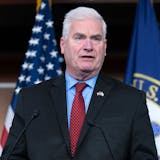Ohio State University and Smith College are the latest institutions to try to spare another generation of undergraduates from shouldering an all-too-common burden: student debt.
Starting next fall, the schools will take loans out of their financial packages and instead pour philanthropic dollars into more grant aid for undergraduates. The decision is rooted in an awareness that affordability is at the heart of national conversations about student debt.
The public policy debate over broad student debt cancellation is forcing colleges to confront their role in a lending system that provides critical access for those wanting to attend but comes at a cost that can limit the value of higher education. Eliminating the need to borrow positions colleges to attract and retain strong students, but sustaining and scaling the policy is challenging.
There is a reason only 76 colleges and universities have adopted no-loan policies since Princeton University's seminal program in 2001: It is expensive. Most schools employing the strategy have large endowments, enroll nominal numbers of needy students and are selective institutions. Some universities counted in the ranks restrict eligibility or have had to scale back their programs.
Still, as institutions compete for the best students - who are increasingly price-sensitive or may lack financial resources - bolstering grants to supplant debt may become a central component of more aid packages.
"Colleges are legitimately worried about student loan debt, but they're also concerned that if they don't do this, they won't be able to compete for the students they want," said Robert Kelchen, a higher education professor at the University of Tennessee at Knoxville.
In many ways, Smith fits the profile of the typical college with a no-loan policy. The liberal arts college in western Massachusetts educates about 2,600 women at the undergraduate level, with a $2 billion endowment. It has a prestigious reputation but Smith President Kathleen McCartney wants to center its inclusiveness with the new financial aid policy.
"There was a real racial disparity in borrowing - 89% of our Black students had loans and only 56% of our White students," McCartney said. "We've been working on a plan to promote racial justice and equity, and we thought we just have to eliminate loans. That will send a powerful message to our students that we are serious about racial justice."



